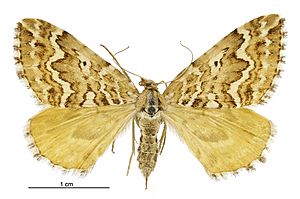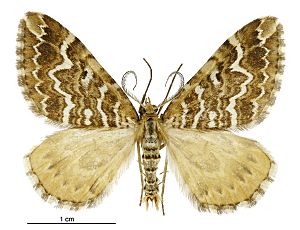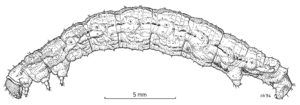Asaphodes clarata facts for kids
Quick facts for kids Asaphodes clarata |
|
|---|---|
 |
|
| Female | |
 |
|
| Male | |
| Scientific classification | |
| Synonyms | |
|
Asaphodes clarata is a species of moth in the family Geometridae. This species is endemic to New Zealand.
Contents
Taxonomy
This species was described by Francis Walker in 1862 as Larentia clarata using material collected in Waikouaiti in Otago. George Hudson discussed and illustrated this species under the name Xanthorhoe clarata in New Zealand moths and butterflies (Macro-lepidoptera). The holotype specimen is held at the Natural History Museum, London.
Description
Hudson described the species as follows:
The expansion of the wings of the male is 1+1⁄2 inches, of the female 1+3⁄8 inches. The species differs from the preceding in the following respects : The ground colour of the forewings is brighter, the markings are less oblique and much more jagged ; the large white central band is often broken up into several distinct oval patches, the costal edge is very slightly shaded with brown, and the transverse lines do not disappear before reaching the costa. The hind-wings are bright ochreous. The cilia of all the wings are white, strongly barred with yellowish-brown.
Distribution
This species is endemic to New Zealand. It is an upland species and occurs on the tussock covered slopes of ranges in both the North and South Islands. It has been recorded as being present in Otago and in Canterbury.
Biology and life cycle
The adults of this species are on the wing in December to February.
Habitat and host species
This species frequents open grassy patches in montane habitat. Larvae of this species feed on the foliage of Ranunculus species. The adult moth has been shown to pollinate Celmisia laricifolia and Hebe pinguifolia.
Images for kids




